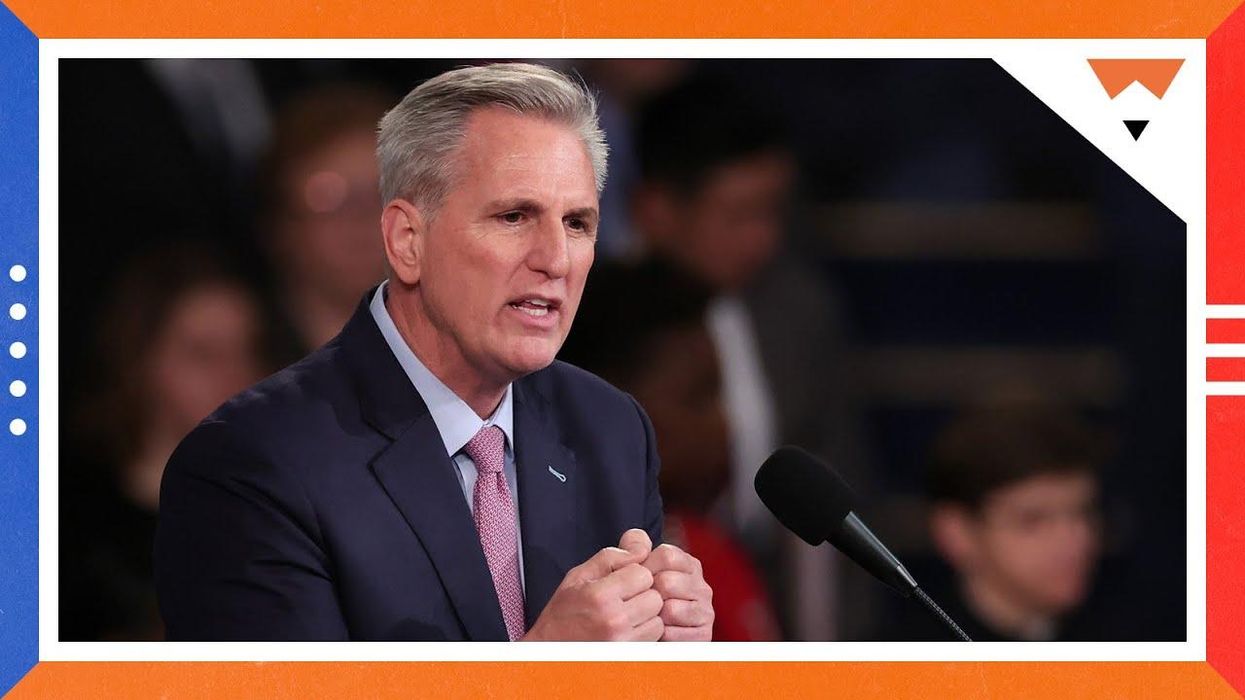Last week, internal Republican Party divisions spilled onto the floor of the House of Representatives in a way rarely publicly seen in Washington. In this installment of the FiveThirtyEight Politics podcast, the crew looks at why it took 15 votes to get Rep. Kevin McCarthy elected House Speaker and what that process says about the two years ahead and the GOP more broadly. They also consider how Rep. George Santos’s scandals will affect his tenure in Congress and whether he would have been elected at all if his fabricated biography had received more scrutiny during the campaign.
Site Navigation
Search
Latest Stories
Start your day right!
Get latest updates and insights delivered to your inbox.
Top Stories
Latest news
Read More
President Donald Trump calls children as he participates in tracking Santa Claus' movements with the North American Aerospace Defense Command (NORAD) Santa Tracker on Christmas Eve at the Mar-a-Lago resort on December 24, 2025 in Palm Beach, Florida.
(Photo by Tasos Katopodis/Getty Images)
A Child Asked about Santa. The President Spoke of Infiltration.
Dec 26, 2025
In the warmth of 'It's a Wonderful Life,' where generosity is a shared civic duty, today's holiday season stands in sharp contrast with the divisive rhetoric that permeates our daily lives. This was poignantly captured in a piece by Amy Lockard in the Fulcrum on Christmas day What ‘It’s a Wonderful Life’ Warns Us About America Today about the holiday season as a time of goodwill — a reminder that this time of year is meant to soften us, widen our circles of concern, and renew our belief that generosity is not a luxury but a civic necessity.
Amy’s writing resonated with me because it captured something I’ve always felt: that the holidays invite us to imagine our better selves.
It was only a matter of time before the day's news intruded on the serene picture, shattering the warm, festive mood.
During the traditional NORAD Santa‑tracking calls on Christmas Eve, a 10‑year‑old from Oklahoma asked the president about Santa’s journey. Instead of the usual light-hearted reassurance, the President spoke of making sure Santa “wasn’t infiltrated,” warning that the United States couldn’t allow any “bad Santas” into the country. He later added that Santa “loves Oklahoma.”
It was a fleeting exchange — the kind that would usually dissolve into the warm blur of holiday ritual. But it also revealed something deeper about the stories we now tell, even in moments meant to be innocent. Our President's language of suspicion, threat, and infiltration has become so normalized in our political bloodstream that it now spills into conversations with children about Santa Claus.
As if this wasn’t enough, today on social media, our President on Christmas day, he wished us all a Merry Christmas by posting this uplifting message of goodwill to all mankind, “to all, including the Radical Left Scum,” while accusing them of “doing everything possible to destroy our Country.” The exact message is:
“Merry Christmas to all, including the Radical Left Scum that is doing everything possible to destroy our Country, but are failing badly. We no longer have Open Borders, Men in Women’s Sports, Transgender for Everyone, or Weak Law Enforcement. What we do have is a Record Stock Market and 401 (k) s, Lowest Crime numbers in decades, No Inflation, and yesterday a 4.3% GDP, two points better than expected. Tariffs have given us Trillions of Dollars in Growth and Prosperity, and the strongest National Security we have ever had. We are respected again, perhaps like never before. God Bless America!!! President DJT”
The holiday season I remember wasn’t about assigning blame or scoring points. Unfortunately, the messages from our President speak to the times we live in.
If one chooses to ignore our President, the holiday season message has endured the test of time. The idea that this is a season of goodwill and love toward all mankind shouldn’t be just about the holiday season, but about the fabric of our nation. It is time to see one another as neighbors rather than threats, and to return to the virtues embodied in the Declaration of Independence: that all men are created equal.
Our President instead has chosen to co-opt Christmas with a fear-based political agenda rather than bring us together as a nation. Goodwill to mankind is not a weakness. Compassion is not partisan.
As we move into 2026, amid the turbulence and uncertainty generated by politicians seeking political advantage, let us return to a more united holiday season. A holiday season that recognizes that our nation has real challenges, but understands that meeting these challenges can be achieved with dignity and honor. Not the version that glosses over real challenges, but the one that insists that how we speak to one another matters. What is the path that you will choose in 2026? Will it help us unite and collaborate, or one that divides? Let this be a time for reflection on the narratives we choose to embrace as we shape our shared future as a nation.
This season invites us to change the path of our nation to one rooted in goodwill, shared humanity, and the belief that we are capable of something larger.
That’s not just a holiday message. It’s a democratic one.
David Nevins is the publisher of The Fulcrum and co-founder and board chairman of the Bridge Alliance Education Fund.
Keep ReadingShow less
Recommended

At Expand Democracy, scholarship is a democratic tool. How research on elections, representation, and governance shapes reform.
Getty Images, Pichsakul Promrungsee
Why Academic Work Matters for a Movement
Dec 25, 2025
When I began publishing research on elections and representation, I always imagined the audience as primarily academic - political scientists, methodologists, perhaps a few practitioners who hunt for new data. But as my work with Expand Democracy deepens, I find myself reflecting on how scholarship shapes the public conversation and why academic writing is not necessarily a detour from democracy but can be a foundation for it.
This essay reflects on that specific interaction: how academic work contributes to our understanding of democratic institutions, why it remains essential for reform movements, and how my own research aligns with Expand Democracy’s evolving mission.
The Role of Academic Writing in Democratic Reform
The value of academic work in democracy reform is not new. Foundational texts in the field, such as Douglas Amy’s Real Choices, New Voices, Arend Lijphart’s Patterns of Democracy, or Jane Mansbridge’s work on representation, did more than present empirical findings. They provided a reference point that activists, funders, journalists, and advocates could all cite and gave the movement a shared vocabulary, empirical grounding, and legitimacy.
Amy’s book, for example, became a canonical reference for proportional representation reformers. It brought analytic rigor and historical depth to a conversation that lacked both. Scholarship in this sense performs a dual function. On the one hand, it disciplines the imagination while simultaneously expanding it. It prevents democratic reform debates from becoming slogans while simultaneously supplying the intellectual framework for new institutional designs. This dual function of constraint and creativity is central to why academic writing remains indispensable to reform organizations.
How my research supports Expand Democracy’s mission
Several of my recent projects address questions at the heart of today’s institutional reform debates.
1. Electoral systems and participation/turnout
My co-authored articles in Electoral Studies (2024) and Social Science Quarterly (2025) examine the relationship between ranked-choice voting and turnout across racial/ethnic groups. These studies draw on multi-year datasets and causal inference tools to answer a question that is often asserted in public debate but rarely rigorously tested: does RCV mobilize voters, depress participation, or do something more complex?
My other recent work for the American Bar Association “2025 report What We Know About Ranked-Choice Voting” reviewed decades of peer-reviewed scholarship on RCV and concluded that, while not a panacea, RCV “provides evidence … of clear benefits in representation, campaign quality, mobilization, and turnout.” This is the kind of evidence-based foundation that my own empirical analyses of turnout shifts and candidate representation seek to build on.
In a political environment where turnout disparities map onto structural inequalities, this research performs both the disciplining and generative functions described above. It closes the gap between rhetoric and reality while generating new questions about when, for whom, and under what conditions reforms improve participation.
2. Representation and political equality
My ongoing research on the descriptive and substantive representation of women, Latino, and Asian candidates under RCV situates local electoral reforms within larger debates about political equality and system responsiveness. These questions are central to both comparative political science and to practical reform efforts seeking to correct representational distortions.
3. Election governance and administrative capacity
As part of the Democracy Exchange Network and in my prior analysis for the Ranked Choice Voting Resource Center, I have contributed to a growing scholarly conversation about election governance and management. This field has historically lacked empirical grounding, but it is increasingly central to democratic stability. My RCV election management report (2024) and my emerging collaborations directly engage questions of institutional design and administrative realism. These analyses help Expand Democracy assess the feasibility of institutional reforms and identify areas where research reveals gaps between theoretical innovation and administrative capacity.
4. Political communication and polarization
My forthcoming article on the far-right podcast ecosystem in the Journal of Radio and Media (with David Dowling) and my book chapter on election fraud beliefs (in M. Ritter’s Rising Above Conspiracy: Understanding Elections, Election Administration, and Democracy in America and Abroad in the 2020s) draw on communication theory and political psychology to analyze how misinformation, identity, and media structure political attitudes. This work is foundational for an organization concerned with voter trust, legitimacy, polarization, and the public understanding of elections. It clarifies the constraints under which reform messaging operates and diagnoses the system-level challenges that undermine democratic participation.
The Relevance of Scholarship Generally to Expand Democracy’s Mission
Expand Democracy’s mission is to strengthen democratic institutions by identifying promising reforms, assessing their viability, and building networks of practitioners, scholars, and policymakers. This orientation places academic knowledge at its crux because it provides analytic clarity. Reform debates often hinge on empirical claims about turnout, about candidate diversity, and about the consequences of electoral rules. Academic work disciplines these claims, allowing organizations like ours to separate empirical outcomes from assumptions.
In addition, scholarship strengthens institutional legitimacy. Funders, policymakers, journalists, and election officials are more likely to engage with reform proposals that have been shown to carry empirical weight. Double blind peer-reviewed publications signal rigor, credibility, and independence, qualities essential in a space that is politically contested.
Last but certainly not least, scholarship informs how we translate ideas for broader audiences. That's why Expand Democracy has formed a Scholars Network to engage regularly with scholars as we consider and discuss new ideas and projects. This helps hone our popular writing like Substack essays, the Democracy Lab podcast, op eds, policy briefs, etc., which are more effective when grounded in research. Academic work gives those narratives depth and precision. Conversely, writing for broader audiences makes scholarly insights actionable rather than insular.
Scholarship as a Democratic Tool
If there is one takeaway from this past year of research is that democracy reform is strongest when rooted in evidence. Movements need stories that resonate, but they also need facts that anchor them. To be sure, not all academic work is constructive, particularly when it arguably exaggerates the inevitable flaws of certain reform proposals without balancing full discussion of the benefits. Yet academic work offers a path to both by providing a depth of understanding and the ability to translate that depth into accessible language for broader audiences.
At Expand Democracy, we’re trying to close the gap between research that sits on a shelf and ideas that change institutions. That means embracing scholarship (my own and others) as a key tenet of our mission. And if Doug Amy’s work taught us anything, it’s that the ideas with the longest shelf life are the ones with strong intellectual foundations. My own publications are one small contribution to this larger ecosystem, but they reaffirm that evidence, now more than ever, is a democratic resource that needs to be utilized.
Dr. Eveline Dowling is a Senior Fellow and Research Analyst at Expand Democracy. She earned her Ph.D. from the University of California, Davis, specializing in public opinion, political behavior, survey research, and election reform.
Keep ReadingShow less

Despite a spike in executions, public support for the death penalty is collapsing. Jury verdicts and polling reveal democracy at work.
the_burtons/Getty Images
The Spirit of Democracy Is Ending America’s Death Penalty
Dec 24, 2025
At first glance, 2025 was not a very good year for the movement to end the death penalty in the United States. The number of executions carried out this year nearly doubled from the previous year.
High-profile killings, like those of Rob Reiner and his wife, made the question of whether the person who murdered them deserves the death penalty a headline-grabbing issue. And the Trump Administration dispensed its own death penalty by bombing boats of alleged drug smugglers.
But if we look beneath the surface, we can see developments in 2025 that signal trouble for America’s death penalty. We can see signs of what I call a democratic erosion in this country’s attachment to capital punishment.
To put it another way, the death penalty is dying from the bottom up, democratically.
It has long been recognized that the death penalty and democracy are incompatible. Democracy, so the argument goes, is more than majority rule. As I have argued elsewhere, “Demands allegiance to ideals of human dignity and equality that are its animating purposes. In my view, any decision that violates those principles is incompatible with democracy….(which) demands that citizens and their government respect the inherent equal worth of each person.”
Fifty years ago, Supreme Court Justice William Brennan said, “a punishment must not be so severe as to be degrading to the dignity of human beings.” The death penalty, he wrote, treats “members of the human race as nonhumans, as objects to be toyed with and discarded….(It is) thus inconsistent with the fundamental premise…that even the vilest criminal remains a human being possessed of common human dignity.”
A long time before Brennan wrote those lines, as I explained, the philosopher John Dewey argued that democracy “Is more than a form of government: it is primarily a mode of associated living, the conjoint communicated experience…. Democracy,” he continued, ”is a way of life controlled by a working faith in the possibilities of human nature.”
The death penalty is a betrayal of that faith.
It assumes we can know with certainty the value and worth of any human life. And when the state sentences someone to death, it claims to know that the condemned person, and no future version of that person, can be worthy of redemption. If Dewey is correct, a person cannot lose or forfeit her worth through indecent conduct or even the most reprehensible behavior.
If we look at what happened to the death penalty in 2025, it seems that Americans are coming around to that view.
The Death Penalty Information Center’s end-of-the-year report offers compelling evidence for that proposition. It acknowledges the spike in executions but points out that “Public support for the death penalty has fallen to a five-decade low (52%) and recent Gallup polling reveals that less than half of U.S. adults ages 18 through 54 now support the death penalty.”
As the DPIC notes, “Support for the death penalty…has been declining since 1994, when support reached a high of 80%. This year’s number is the lowest since 1972…. Gallup also found that 44% of Americans now oppose the death penalty — the highest level of opposition recorded since May 1966. Opposition to capital punishment has been increasing since the 1990s, and has more than tripled since 1995, when only 13% of Americans opposed the death penalty. “
Most importantly, “just 41% of people 18 to 34 years old now support the death penalty. This difference marks a significant drop in support over the past 15 years. For example, Gallup’s 2011 poll found 62% of people 30 to 49 years old and 52% of young adults 18 to 29 years old favored the death penalty.”
These findings suggest that in the future, as older people whose attachment to the death penalty may be rooted in an earlier era die, the public’s overall attachment to capital punishment is likely to weaken. As it does, political leaders will have even more room than they do today to curb or end it.
Jury verdicts offer another important indicator of the death penalty’s democratic decline in 2025. Jury service offers citizens the opportunity to make their voices heard in a direct way.
As Professor Maxwell Chibundu explains, “The jury process affords citizens an unparalleled opportunity to participate directly in the process of self-governance. In the courtroom and its precincts, an otherwise indifferent citizen is made to confront the responsibility of evaluating the conduct of her fellow citizens, familiarizing herself with the legal rules and norms of our society, gauging governmental conduct, and ultimately calling the parties to account for their conduct.”
Because juries are drawn from a cross section of the population, “the composition of the jury and its verdict are…microcosms of the larger society.” That is why what juries do helps gauge the extent and depth of popular support for the death penalty.
And what did juries in capital cases do in 2025?
As the DPIC reports, “Fewer than half of the more than 50 capital trials that reached the sentencing phase this year resulted in a death sentence. “ The total number of new death sentences was 22.
Those new death sentences were handed down in just five states. 2025 is, the DPIC says, “the fifth year in a row with fewer than 30 people sentenced to death in a single year and the eleventh year in a row with fewer than 50 new death sentences, demonstrating the growing reluctance by juries to impose death.”
It highlights the fact that “in the two states where prosecutors most often sought the death penalty, Alabama and Florida, juries were markedly reluctant to reach a sentence of death. In Alabama, only one-fifth (4/20) of death-qualified juries recommended death sentences. In Florida, half (6/12)2 of death-qualified juries recommended death sentences.”
When Americans are asked to do the work of deciding whether a particular defendant convicted of a capital crime should be executed, they are increasingly likely to say no. This is all the more significant as a way of registering democratic dissatisfaction with the death penalty because only people who have no conscientious objection to capital punishment can serve on juries. That means that opponents of the death penalty do not get to serve on capital juries.
The more that people see the death penalty up close, the less likely they are to endorse its use. That is why jury verdicts provide indicators of an erosion of the death penalty in this country, rooted in democratic practices.
Whatever their general views about it, jurors are having a harder time than ever in seeing it as an appropriate punishment, even for those who commit gruesome crimes.
Writing almost twenty years ago, the political theorist George Kateb argued that “the spirit of democracy” could not be reconciled with a “zeal“ for harsh punishment. 2025 suggests that Americans’ zeal for one form of harsh punishment, the death penalty, is waning.
There is a real prospect that this country can end it through democratic means. And our democracy will be better for it.
Austin Sarat is the William Nelson Cromwell professor of jurisprudence and political science at Amherst College.
Keep ReadingShow less

As Australia bans social media for kids under 16, U.S. parents face a harder truth: online safety isn’t an individual choice; it’s a collective responsibility.
Getty Images/Keiko Iwabuchi
Parents Must Quit Infighting to Keep Kids Safe Online
Dec 24, 2025
Last week, Australia’s social media ban for children under age 16 officially took effect. It remains to be seen how this law will shape families' behavior; however, it’s at least a stand against the tech takeover of childhood. Here in the U.S., however, we're in a different boat — a consensus on what's best for kids feels much harder to come by among both lawmakers and parents.
In order to make true progress on this issue, we must resist the fallacy of parental individualism – that what you choose for your own child is up to you alone. That it’s a personal, or family, decision to allow smartphones, or certain apps, or social media. But it’s not a personal decision. The choice you make for your family and your kids affects them and their friends, their friends' siblings, their classmates, and so on. If there is no general consensus around parenting decisions when it comes to tech, all kids are affected.
According to More in Common, which recently surveyed parents in the U.S., U.K., France and Poland on their thoughts and experiences around online safety, 65% of U.S. parents are “very” concerned about their kids’ safety online, and another 28% are “somewhat” concerned (leaving 7% of parents not that concerned at all – a troubling number, even if it seems low).
And according to the researchers, deeper focus group sessions (which you can dive into by downloading the report here) showed many parents feel that other parents are undermining their ability to keep their children safe. Specifically, the researchers note that, “Differences in approaches between parents are seen as a source of tension, and a way for children to bypass the rules in their own household. This can lead to parents feeling powerless.”
Perhaps parents feel powerless because so often they are alone in this fight, given that the burden of responsibility for keeping kids safe online is lobbed squarely onto parents rather than onto the technology companies where it belongs. This is not by accident, or by default, but is a result of the democratic process failing to protect the most vulnerable among us – our children – from Big Tech. When there is no corporate accountability, the result is infighting and an inability for civil society to form a strong, united front.
We are in a divisive time in this country, politically, but we must not be divisive on this issue, and changing community norms is one of the best defenses we have right now against the risks our kids are facing. We know child sexual abuse material can be found on every platform. We know social media is problematic for a multitude of reasons for kids under 16 (and even older). The online realm, especially now that AI has exploded with essentially no guardrails and major support from the current administration, is only getting crazier and more dangerous. AI toys are the newest threat and should make every parent lose sleep at night.
Certainly not all kids are the same – what one child can handle online might be very different for the next child. And parents are the best judges of that. But let’s be real – not all parents are diligent or, as the More in Common research shows, all that concerned about the mental and physical risks posed to young people when they go online. We can be pro-tech and also pro-safety, but we have to be able to talk to each other and come to some agreement around what we, as a country, will allow for our children. But we won’t come to a consensus without first agreeing that it’s a collective problem with collective consequences.
There is legislation that will help to fight this problem and hold tech companies responsible for what happens on their platforms. And we must support this sort of policy action to get to the root cause. But as parents, the greatest power we have is our ability to come together. We must not let parental individualism get in our way of protecting our kids online.
Keep ReadingShow less
Load More
















